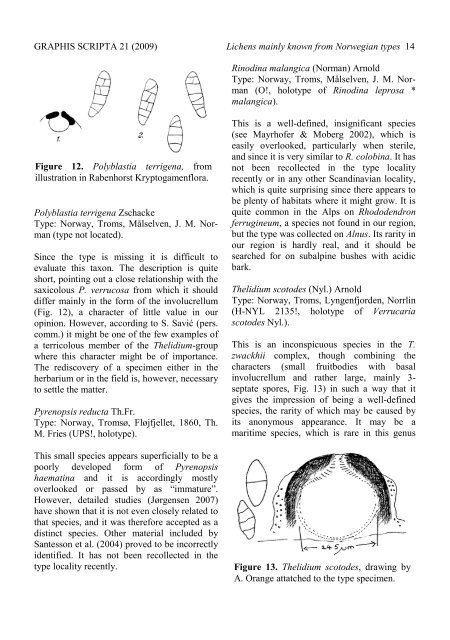(2009): Lichens in Scandinavia known mainly from Norwegian type ...
(2009): Lichens in Scandinavia known mainly from Norwegian type ...
(2009): Lichens in Scandinavia known mainly from Norwegian type ...
You also want an ePaper? Increase the reach of your titles
YUMPU automatically turns print PDFs into web optimized ePapers that Google loves.
GRAPHIS SCRIPTA 21 (<strong>2009</strong>) <strong>Lichens</strong> ma<strong>in</strong>ly <strong>known</strong> <strong>from</strong> <strong>Norwegian</strong> <strong>type</strong>s 14<br />
Figure 12. Polyblastia terrigena, <strong>from</strong><br />
illustration <strong>in</strong> Rabenhorst Kryptogamenflora.<br />
Polyblastia terrigena Zschacke<br />
Type: Norway, Troms, Målselven, J. M. Norman<br />
(<strong>type</strong> not located).<br />
S<strong>in</strong>ce the <strong>type</strong> is miss<strong>in</strong>g it is difficult to<br />
evaluate this taxon. The description is quite<br />
short, po<strong>in</strong>t<strong>in</strong>g out a close relationship with the<br />
saxicolous P. verrucosa <strong>from</strong> which it should<br />
differ ma<strong>in</strong>ly <strong>in</strong> the form of the <strong>in</strong>volucrellum<br />
(Fig. 12), a character of little value <strong>in</strong> our<br />
op<strong>in</strong>ion. However, accord<strong>in</strong>g to S. Savić (pers.<br />
comm.) it might be one of the few examples of<br />
a terricolous member of the Thelidium-group<br />
where this character might be of importance.<br />
The rediscovery of a specimen either <strong>in</strong> the<br />
herbarium or <strong>in</strong> the field is, however, necessary<br />
to settle the matter.<br />
Pyrenopsis reducta Th.Fr.<br />
Type: Norway, Tromsø, Fløjfjellet, 1860, Th.<br />
M. Fries (UPS!, holo<strong>type</strong>).<br />
This small species appears superficially to be a<br />
poorly developed form of Pyrenopsis<br />
haemat<strong>in</strong>a and it is accord<strong>in</strong>gly mostly<br />
overlooked or passed by as “immature”.<br />
However, detailed studies (Jørgensen 2007)<br />
have shown that it is not even closely related to<br />
that species, and it was therefore accepted as a<br />
dist<strong>in</strong>ct species. Other material <strong>in</strong>cluded by<br />
Santesson et al. (2004) proved to be <strong>in</strong>correctly<br />
identified. It has not been recollected <strong>in</strong> the<br />
<strong>type</strong> locality recently.<br />
R<strong>in</strong>od<strong>in</strong>a malangica (Norman) Arnold<br />
Type: Norway, Troms, Målselven, J. M. Norman<br />
(O!, holo<strong>type</strong> of R<strong>in</strong>od<strong>in</strong>a leprosa *<br />
malangica).<br />
This is a well-def<strong>in</strong>ed, <strong>in</strong>significant species<br />
(see Mayrhofer & Moberg 2002), which is<br />
easily overlooked, particularly when sterile,<br />
and s<strong>in</strong>ce it is very similar to R. colob<strong>in</strong>a. It has<br />
not been recollected <strong>in</strong> the <strong>type</strong> locality<br />
recently or <strong>in</strong> any other Scand<strong>in</strong>avian locality,<br />
which is quite surpris<strong>in</strong>g s<strong>in</strong>ce there appears to<br />
be plenty of habitats where it might grow. It is<br />
quite common <strong>in</strong> the Alps on Rhododendron<br />
ferrug<strong>in</strong>eum, a species not found <strong>in</strong> our region,<br />
but the <strong>type</strong> was collected on Alnus. Its rarity <strong>in</strong><br />
our region is hardly real, and it should be<br />
searched for on subalp<strong>in</strong>e bushes with acidic<br />
bark.<br />
Thelidium scotodes (Nyl.) Arnold<br />
Type: Norway, Troms, Lyngenfjorden, Norrl<strong>in</strong><br />
(H-NYL 2135!, holo<strong>type</strong> of Verrucaria<br />
scotodes Nyl.).<br />
This is an <strong>in</strong>conspicuous species <strong>in</strong> the T.<br />
zwackhii complex, though comb<strong>in</strong><strong>in</strong>g the<br />
characters (small fruitbodies with basal<br />
<strong>in</strong>volucrellum and rather large, ma<strong>in</strong>ly 3septate<br />
spores, Fig. 13) <strong>in</strong> such a way that it<br />
gives the impression of be<strong>in</strong>g a well-def<strong>in</strong>ed<br />
species, the rarity of which may be caused by<br />
its anonymous appearance. It may be a<br />
maritime species, which is rare <strong>in</strong> this genus<br />
Figure 13. Thelidium scotodes, draw<strong>in</strong>g by<br />
A. Orange attatched to the <strong>type</strong> specimen.

















